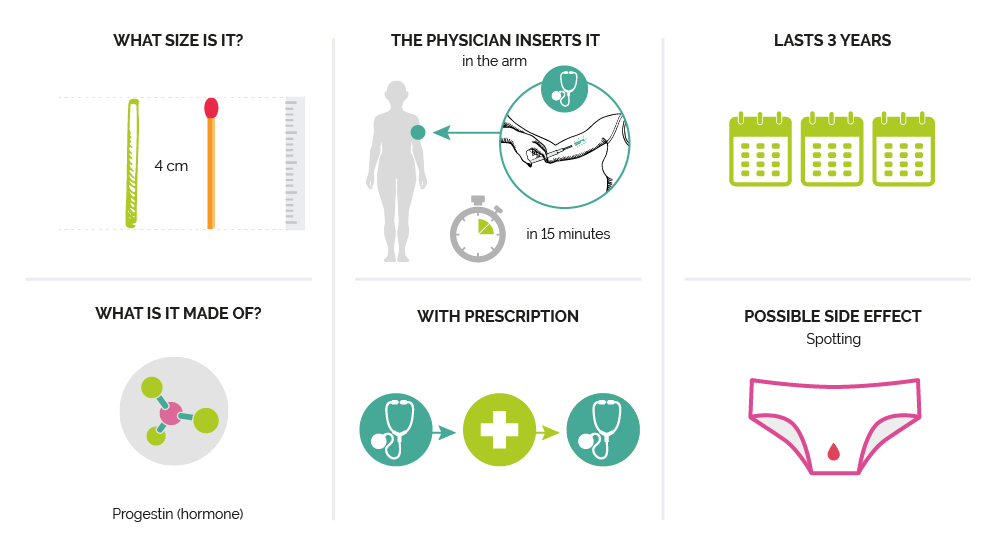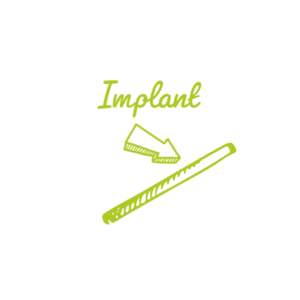THE HORMONAL IMPLANT
Also called a contraceptive implant, it is placed under the skin of the arm and releases hormones continuously for three years.
*Source: effectiveness percentages are taken from WHO (2018)
HOW DOES IT WORK?
This little stick is placed under the skin of your arm. It continuously diffuses a low dose of hormones in your body to block ovulation for three years. It thickens the cervical mucus and acts on the endometrium, making it more difficult for sperm to enter the uterus. With this method, menstruation can be irregular, very weak, or absent.
INTERESTING FIGURES AND DETAILS

HOW TO USE IT?

BACKGROUND
Visit a physician or gynaecologist who will provide you with a prescription. Ask if he or she is familiar with the placement of hormonal implants.
STEP 1
After buying the implant at a pharmacy, return to your physician, gynaecologist, or family planning center to perform the procedure.
STEP 2
The implant is inserted under the skin of the arm, usually on the first day of periods, after a local anesthesia, which makes the insertion painless.
STEP 3
Have the implant replaced every three years by a physician or gynecologist.
WHERE TO GET IT?
Starting 1 April 2023, this contraceptive is delivered free of charge on medical prescription in any Luxembourg pharmacy to people affiliated with the National Health Fund, with no age limit.
For more information: click here.
This contraceptive can also be delivered for free at the Family Planning, including to people not covered by National Health Fund.
An implant costs on average 140€* for 3 years.
*(The price is an average indication which may vary)
Advantages
- The implant is a very reliable method of contraception (99.9%*), even in case of vomiting or having diarrhea.
- You don’t have to think about it every day or every time you are having sex.
- It can be removed at any time if you want to get pregnant or change your contraceptive method. After removal of the implant, you will return to your original fertility level.
- Suitable for women who are breastfeeding.
- You can’t see or feel it (unless you apply a little pressure to the skin over the implant).
GOOD TO KNOW
- The implant does not protect against sexually transmitted infections. Therefore, remember to use condoms when you have a new partner.
- The implant affects your menstrual flow. Some women have no periods at all for three years or only occasional light spotting. Others have either less frequent periods, sometimes shorter (a few days), sometimes longer (up to ten days). It is therefore difficult to predict the time of menstruation and impossible to postpone it.
- It reduces (or eliminates in some cases) heavy and painful periods.

FREQUENTLY ASEKD QUESTIONS
Does the insertion and removal of an implant hurt?
The insertion and removal of the implant is done under local anesthetic to avoid pain. If you have any concerns about pain, you can discuss them with your physician. Most women experience only a little pain at the insertion point in the hours following insertion. Note that the insertion is always done in the arm of the non-dominant hand, i.e. in the left arm if you are right-handed, and vice versa.
The removal of the implant is usually uncomplicated, but may take a little longer than the insertion. The removal is done under local anesthetic and a small incision is made by the physician to remove the implant. Stitches are usually not necessary.
Is it possible to have an implant placed on the same day that the previous one is removed?
Yes. In fact, as soon as an implant is removed, a second implant can be inserted immediately in the same place as the previous one.
If my period decreases or disappears with the implant, is it dangerous not having period for 3 years?
No, it is not dangerous for your health! When you take hormonal contraception, the body simulates a hormonal situation similar to that of the 2nd trimester of pregnancy. Saying that not having your period on the pill is dangerous would be like saying that not having your period during pregnancy is dangerous.
Can I get a tattoo where my implant is inserted?
It is possible to have an implant inserted if you are already tattooed at the insertion site. However, if you use the implant and wish to have a tattoo at this location, it is advisable to avoid it. Indeed, tattooing as such can lead to a risk of breakage of the implant which, is inserted in a rather superficial way under the skin. It is therefore preferable to get a tattoo in a different place.
Can I get vaccinated in the same arm as my implant?
Yes, no problem. Vaccination has no effect on the effectiveness of the implant and vice versa. Vaccination triggers an immune response, while the implant is a reservoir that continuously releases a small amount of synthetic hormones. Both processes can take place at the same time, without any danger to your health, as they are independent from each other. Moreover, it should be noted that the vaccine is injected on the upper arm, while the implant is inserted in the inner arm. There is therefore no chance of a “collision”.
Does the implant contain metal or batteries?
No, it is not an electronic device. The hormonal implant is made of synthetic material, which is not degradable in the body. There is therefore no reason why it should be detectable by a metal detector, for example if you are taking a flight.
Does my implant contain data about me?
No. The implant contains only the progestin hormones needed to provide contraception. It does not contain any information about you.
Can the implant move and get lost in the body?
This is very rare. However, the implant may move into the arm or even into a blood vessel. However, you can feel the implant by touching/palpate your arm. You can therefore check for yourself whether your implant has moved or not. If you can no longer feel your implant, consult your physician.



